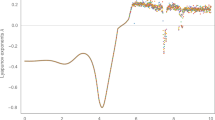Abstract
This paper presents an analysis of representation and stability properties of dynamical systems whose signals are assumed to be square summable sequences. Systems are defined as families of trajectories with no more structure than linearity and shift invariance. We depart from the usual input-output and operator theoretic setting and view relationships among system variables as a more general starting point for the study of dynamical systems. Parametrizations of two model classes are derived in terms of analytic functions which define kernel and image representations of dynamical systems. It is shown how state space models are derived from these representations. Uniqueness and minimality of these representations are completely characterized. Elementary properties like stabilizability, regularity, and interconnectability of dynamical systems are introduced and characterized in this set theoretic framework.
Similar content being viewed by others
References
T. Chen and B. Francis,Optimal Sampled-Data Control Systems, Communications and Control Engineering Series, Springer-Verlag, London, 1995.
F. Fagnani and J. C. Willems, Controllability of ℓ2 Systems,SIAM Journal on Control and Optimization,30(5) (1992), 1101–1125.
B. A. Francis,A Course in H ∞ Control Theory, Lecture Notes in Control and Information Sciences, Vol. 88, Springer-Verlag, Berlin, 1987.
P. A. Fuhrmann, Algebraic System Theory: an Analyst's Point of View,Journal of the Franklin Institute,301 (1976), 521–540.
P. A. Fuhrmann,Linear Systems and Operators in Hilbert Space, McGraw-Hill, New York, 1981.
T. T. Georgiou and M. C. Smith, Graphs, Causality, and Stabilizability: Linear, Shift-Invariant Systems on L2[0, ∞),Mathematics of Control, Signals, and Systems,6 (1994), 195–223.
M. Green and D. J. N. Limebeer,Linear Robust Control, Information and System Sciences Series, Prentice-Hall, Englewood Cliffs, NJ, 1995.
C. Heij,Deterministic Identification of Dynamical Systems, Lecture Notes in Control and Information Sciences, vol. 127, Springer-Verlag, Berlin, 1989.
M. Kuijper, Why Do Stabilizing Controllers Stabilize?,Automatica 31 (1995), 621–625.
M. Kuijper and J. M. Schumacher, Realization of Autoregressive Equations in Pencil and Descriptor Form,SIAM Journal on Control and Optimization,28(5) 1990, 1162–1189.
R. J. Ober and J. A. Sefton, Stability of Control Systems and Graphs of Linear Systems,Systems and Control Letters,17 (1991), 265–280.
B. Roorda, Global Total Least Squares: a Method for the Construction of Open Approximate Models from Vector Time Series, Ph.D. thesis, Tinbergen Institute Research Series, No. 88, Rotterdam, 1995.
M. Rosenblum and J. Rovnyak,Hardy Spaces and Operator Theory, Oxford University Press, New York, 1985.
J. A. Sefton and R. J. Ober, On the Gap Metric and Coprime Factor Perturbations,Automatica,19 (1993), 723–734.
H. L. Trentelman and J. C. Willems, ℋ∞ Control in a Behavioral Context, submitted toIEEE Transactions on Automatic Control, 1996.
F. Treves,Topological Vector Spaces, Distributions and Kernels, Academic Press, New York, 1967.
S. Weiland, A. A. Stoorvogel, and B. de Jager. A Behavioral Approach to the ℋ∞ Optimal Control Problem, accepted for publication inSystems and Control Letters, 1997.
J. C. Willems, Input-Output and State-Space Representations of Finite-Dimensional Linear Time-Invariant Systems,Linear Algebra and its Applications,50 (1983), 581–608.
J. C. Willems, From Time Series to Linear Systems, Part I: Finite Dimensional Linear Time Invariant Systems; Part II: Exact Modeling,Automatica,22 (1986), 561–580, 675–694.
J. C. Willems, From Time Series to Linear Systems, Part III: Approximate Modelling,Automatica,23 (1987), 87–115.
J. C. Willems, Paradigms and Puzzles in the Theory of Dynamical Systems,IEEE Transactions on Automatic Control,36 (1991), 259–294.
J. C. Willems, Feedback in a Behavioral Setting, inSystems, Models and Feedback: Theory and Applications (eds. A. Isidori and T. J. Tarn), pp. 179–191, Birkhäuser, Boston, 1992.
J. C. Willems, On Interconnections, Control, and Feedback,IEEE Transactions on Automatic Control,42 (1997), 326–339.
Author information
Authors and Affiliations
Additional information
Part of this research has been made possible by a grant from the European Community for the Systems Identification and Modeling Network (SIMONET).
This research has been made possible by a fellowship of the Royal Netherlands Academy of Sciences and Arts.
Rights and permissions
About this article
Cite this article
Weiland, S., Stoorvogel, A. Rational representations of behaviors: Interconnectability and stabilizability. Math. Control Signal Systems 10, 125–164 (1997). https://doi.org/10.1007/BF01213383
Received:
Revised:
Issue Date:
DOI: https://doi.org/10.1007/BF01213383




